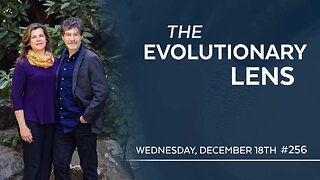Premium Only Content

Vitamin D Explained: The Evidence for Prevention and Treatment of Coronavirus (SARS CoV 2)
Vitamin D3 (Cholecalciferol) and Vitamin D2 (Ergocalciferol) and Calcitriol | All About Vitamin D
What are all of these things?
They refer to the various forms of Vitamin D in our bodies or in the food we eat. For example, vitamin D3 is also known as cholecalciferol; this is made naturally by the body in response to sunlight. Vitamin D2 is also known as Ergocalciferol and comes from plants. Vitamin D supplements come in the form of either Vitamin D3 or Vitamin D2. If you prefer, calcitriol or 1,25-dihydroxy vitamin D is the active form of vitamin D in our body. When sunlight contains ultraviolet B (UVB) radiation, and when it hits your skin cells, it turns 7-dehydrocholesterol into vitamin D3, meaning cholecalciferol. Vitamin D3, in turn, binds to vitamin D-binding protein (VDBP) and is transported to the liver, where it gets converted to calcidiol, aka 25-hydroxyvitamin D.
Calcidiol is the storage form of vitamin D in the body. Calcidiol is later converted to the active form of vitamin D in the body, meaning calcitriol, or 1,25-dihydroxy vitamin D. This conversion of calcidiol into calcitriol mainly occurs in the kidney. But it also takes place in different tissues and cells of the immune system, such as lymph nodes and alveolar macrophages. And not only in alveolar macrophages but the alveoli themselves.
Vitamin D3 is only found naturally in a few different food sources, mainly fatty fish, like cod, swordfish, tuna, and salmon. Milk doesn't naturally contain vitamin D3, but it has been fortified with it for almost 100 years now. But other dairy products made from milk like cheese and ice cream aren't typically fortified with vitamin D and contain only small amounts. So to meet the RDA of 800 IU, older adults would have to drink about 4 cups of fortified milk per day. Vitamin D3 mainly comes from sunlight, though, not food. But the skin's vitamin D production depends on several factors, only some of which you have control.
Depending on the season, where you live, where you travel, the time of day, the clothing you wear, and the umbrella you use, all of these factors determine how much UVB light hits your skin. The sun's rays are most direct between 10 a.m. and 3 p.m. However, the farther you live from the equator, the less UVB radiation you receive. People who live north of about 37° latitude can't make any vitamin D from sunlight from November to March.
Why is this the case?
During the winter months, the earth tilts away from the sun, ultimately leading to fewer sun rays hitting the earth. Having darker skin means less UVB absorption, which means less vitamin D3 production. Also, as we age, our bodies become less efficient at converting UVB light into vitamin D3. This is why older people and darker skin people are more prone to have lower vitamin D levels. Many older people have reduced exposure to sunlight for different reasons and may not be getting enough vitamin D in their diet to make matters worse.
Vitamin D signals the intestines to absorb calcium into the bloodstream.
This happens even if you have enough calcium in your diet. Besides strengthening bones, vitamin D helps reduce fractures in the elderly by preventing muscle deterioration and reducing the chances of falling.
The official definition of a vitamin deficiency means that specific health problems arise due to not having enough of a particular nutrient. True vitamin D deficiency in children causes rickets, a bone disease where the legs become bowed. This is rare in the United States. Vitamin D deficiency in adults can lead to osteomalacia and osteoporosis, leading to bone fractures. So what if you don't have deficiency per se, but you have less-than-ideal levels of a specific vitamin? Well, this can increase your risk of various health issues, even though they are not solely responsible for these problems. This is what we call "Insufficiency."
Most medical societies consider someone with vitamin D insufficiency if their level is between 12 to 20 ng/mL (30 to 50 nmol/L), and Vitamin D deficiency is less than 12 ng/mL (30 nmol/L). Most experts consider normal levels to be above 20 and less than 50 ng/ml. Most people in the United States have values around 20 ng/ml.
But having too high levels can cause other health issues. In one study, levels above 32 ng/ml resulted in people getting less quality sleep. The risk of vitamin D toxicity typically occurs at levels over 100 ng/mL in adults who also ingest substantial calcium amounts. Vitamin D toxicity, whether it's from vitamin D3 or vitamin D2, generally occurs after inappropriate use of vitamin D. It's essential to avoid excess vitamin D in pregnancy because that can cause calcium levels to rise to the point of causing seizures in the mother and developmental problems in the baby.
Doctor Mike Hansen, MD
Internal Medicine | Pulmonary Disease | Critical Care Medicine
-
 1:00:36
1:00:36
PMG
21 hours ago $0.66 earned"Santa Trump is Giving Us Hope - But Will Johnson Stand Strong?"
8.06K6 -
 54:30
54:30
LFA TV
1 day agoThe German Strongman’s Arrival Is Imminent | Trumpet Daily 12.18.24 7PM EST
15.8K2 -
 2:04:11
2:04:11
Melonie Mac
5 hours agoGo Boom Live Ep 32! Soul Reaver Remastered!
16.5K6 -
 39:11
39:11
Sarah Westall
2 hours agoDigital Slavery and Playing with Fire: Money, Banking, and the Federal Reserve w/ Tom DiLorenzo
28K1 -
 1:38:38
1:38:38
2 MIKES LIVE
7 hours ago2 MIKES LIVE #157 ILLEGALS, PROTESTORS AND DRONES!
16.9K1 -
 1:01:03
1:01:03
LFA TV
1 day agoTHE LATEST SPENDING BILL IS AN ABOMINATION! | UNGOVERNED 12.18.24 5pm EST
23K33 -
 1:43:34
1:43:34
Redacted News
6 hours agoBREAKING! WARMONGERS PUSHING TRUMP TO LAUNCH PRE-EMPTIVE WAR WITH IRAN | Redacted News
125K224 -
 1:00:26
1:00:26
Candace Show Podcast
5 hours agoPiers Morgan x Candace Owens | Candace Ep 123
70.7K193 -
 2:06:51
2:06:51
Darkhorse Podcast
8 hours agoThe 256th Evolutionary Lens with Bret Weinstein and Heather Heying
55.8K25 -
 3:08:08
3:08:08
Scammer Payback
6 hours agoCalling Scammer Live
33.5K3